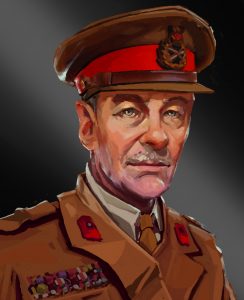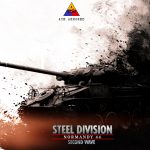Let’s focus today on the 21st Army Group‘s best division in North-Western Europe: the 15th (Scottish) Infantry Division.
ORIGINS
The 15th (Scottish) Infantry Division, disbanded after WW1, was re-activated in March 1939 as part of the Territorial Army to expand the size of the British Army in the prospect of a new conflict with Germany. Although mobilized two days before the outbreak of WW2, the division remained in the UK for the next five years, having ample time training but lacking equipment: in the wake of the evacuation of Dunkirk, the division had to give up most of its heavy weapons to re-equip the Regular Army.
Relocated South to Northumberland (“banished to Northumberland” in the exact words of the 6th Battalion, Royal Scots Fusiliers‘s regimental diary), it was tasked with watching over the coast where the Germans were expected to land in the case of an invasion. By 1943, under their new commander Major-General Gordon McMillan, the division was finally earmarked for participation in the invasion of Europe and moved to Scriven Camp in Yorkshire where it was relentlessly trained. A strong emphasis was put on river crossings and infantry-armor cooperation, a training which will prove most useful since the 15th (Scottish) will be involved in all of the British Army’s major river assault crossings in North-Western Europe, from Normandy’s smaller waterways to the Seine, Rhine & Elbe river.
In Yorkshire, the division took part in several major exercises (“Blackstock” in Fall 1943, “Clansman” in January 1944 & “Eagle” one month later) and was visited by General Montgomery himself on February 7th, 1944 and Winston Churchill on March 31st. By the end of their training, a veteran remembered that rations improved significantly which, with the recent visits referred above, led the men to conclude that D-Day was close and they were “fattened for the kill“.
THE ‘SCOTTISH CORRIDOR’
The division was ferried to Normandy on June 24th, 1944, three weeks after D-Day. The Allied offensive had stalled and General Montgomery was eager to receive the reinforcements delayed by the June 19th to 21st’ storm which had damaged the British Mulberry harbor and destroyed the American one. Merely two days after its landing, 15th (Scottish) was engaged in Operation Epsom.

Men of 7th Seaforth Highlanders, 15th (Scottish) Division advancing during Operation ‘Epsom’, June 26th, 1944
For their baptism of fire, the Scots were given the first row: they would be leading the charge toward for Hill 112, a small outcrop East of Caen considered by both Allied & German planners as the “key to the Normandy”. On June 26th, after a tremendous barrage, the 15th (Scottish) attacked South with the support of 31st Tank Brigade‘s Churchill tanks. Although untested in combat, the Scots advanced with determination in the face of fanatical resistance from the young 12. SS Panzergrenadiers and armored counter-attacks on its flank by 21. Panzer and 12. SS-Panzer. The next day saw more of the same, yet they managed to secure a crossing over the Odon river, allowing the rest of VIII. Corps to roll straight to Hill 112. So thin was the division’s salient that it was dubbed “the Scottish Corridor“, constantly under attack on both flanks by more Panzer divisions. But the Scots not only stood their ground, they slowly expanded it!
Having done their part, the Scots were only used in support of Operation Jupiter, the first battle Hill 112 one week later. But the “Hill of Calvary” was a tough nut to crack, and it would take more than one offensive to take it … Early in August, General MacMillan was wounded and replaced by 46th Brigade‘s commander Colin “Tiny” Muir Barber, thus nicknamed for he was 6 ft. 9 in. (about 2m06)! When the Americans finally broke out of Cotentin and bocage country after Operation Cobra, causing the disintegration of the German Army, the British immediately initiated their own Operation Bluecoat, striking near Caumont, at the junction between the US & UK armies. From then on, the 15th (Scottish) was on the move again and wouldn’t stop before the end of the war …AFTER NORMANDY
Pursuing the fleeing German army across France, Belgium & the Netherlands, the Scots led the crossing of the Seine (August 28th), took part in the liberation of Belgium, in the ill-planned Operation Market Garden, then Operation Veritable, Operation Plunder (the assault crossing of the Rhine river) and finally Operation Enterprise (the assault crossing of the Elbe river).
The end of the war found the 15th (Scottish) Infantry Division on the coast of the Baltic see. It was disbanded in April 1946.THE 15TH (SCOTTISH) INFANTRY DIVISION INGAME
The Scots can count on a numerous, cheap yet reliable infantry from Phase A, advancing with close-support Churchill V armed with a 95mm howitzer and even a single AVRE with its huge 290mm Petard gun designed to blow up concrete bunker. Restricted to a few 2-Pdr Mortars as artillery support, it has to rely for a while on Spitfire & Typhoon in ground attack role to support its advance.
Phase B is to Normandy 44 what the Scot Grey‘s attack was to Waterloo: the mad charge with everything they got. With infantry in greater number, now backed by Assault Pioneers and large numbers of slow but sturdy Churchill, including up-armored variants & the dreadful Crocodile flamethrower tank, the Scots are like a (orange?) wave slowly but relentlessly advancing on the enemy. By then, the artillery tab provides more than enough indirect firepower to support the division’s advance, from the excellent 25-pdr gun to medium mortars and off-map artillery.
To deal with armored threats, the Scots have to rely on the powerful but cumbersome 17-pdr guns, with only Wolverines (armed with the less efficient American 76,2mm) and a single Challenger as mobile anti-tank guns. Another efficient tank killer available to the division being the Typhoon AT with its armor-piercing rockets.
Phase C brings more or better of the same, although the division’s economy starts stalling. The recon tab can now field a good number of heavy armored car in the form of Daimler AC and its Little John-equipped variant, for the last “recon in force” push…


![24_juin_epsom-1[1]](https://eugensystems.com/wp-content/uploads/2017/08/24_juin_epsom-11-232x300.jpg)
![montgomery[1]](https://eugensystems.com/wp-content/uploads/2017/07/montgomery1-300x226.jpg)
![51st-Highland-Div-Rhine-595x584[1]](https://eugensystems.com/wp-content/uploads/2017/07/51st-Highland-Div-Rhine-595x5841-300x294.jpg)






Henrietta Grant-Peterkin
September 15, 2017 at 2:57 pmUnder ‘Scottish Corridor’ I note that you mention someone you call ‘Tiny’ Muir: “Early in August, General MacMillan was wounded and replaced by 46th Brigade‘s commander Colin “Tiny” Muir, thus nicknamed for he was 6 ft. 9 in. (about 2.6m)!”
My father (Brigadier James Alexander Grant-Peterkin, 1909-1981, Cameron Highlanders, established the Scottish Reconnaissance Regiment, later was seconded to command 1st Bn The Gordon Highlanders…) was a very good friend of ‘Tiny’… whose surname was in fact BARBER not Muir. He was General Colin ‘Tiny’ Barber. I remember General Barber coming to stay at our family home when I was a girl! See also the book by ?… Saunders ‘Hill 112’… and various photos therein.
Best regards,
HenriettaGP
(in Moray, Scotland)
E: henriettagp@yahoo.com
Henrietta Grant-Peterkin
September 15, 2017 at 2:59 pmI’ve just checked… his full name was Colin ‘Tiny’ Muir BARBER
Google him and see Wikipedia !
Best regards,
Henrietta Grant-Peterkin
(no need to post my comments but please correct ‘Muir’ !
[EUG]MadMat
September 15, 2017 at 4:17 pmHi,
Thanks for the information. I had came across the full name Colin Barber Muir before, but had skipped the second as a middle name, as we’re doing for most other historical figures … since in that time, they tended to have pretty long ones. 🙂
We will fix that.
Regards.